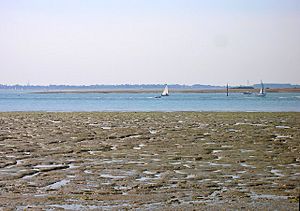Pilsey Island facts for kids
Quick facts for kids Pilsey Island |
|
|---|---|
 |
|
| Type | Local Nature Reserve |
| Location | Chichester Harbour, West Sussex |
| OS grid | SU 770 007 |
| Area | 17.8 hectares (44 acres) |
| Managed by | Royal Society for the Protection of Birds |
Pilsey Island is a special place for nature in Chichester Harbour, located in West Sussex, England. It is a Local Nature Reserve, which means it is protected for its wildlife and natural features. The island is about 17.8 hectares in size, which is roughly the size of 25 football fields!
This important island is owned by the Ministry of Defence, which is the part of the UK government responsible for the country's armed forces. However, it is looked after and managed by the Royal Society for the Protection of Birds (RSPB), a well-known charity that works to protect birds and the places they live.
Contents
What Makes Pilsey Island Special?
Pilsey Island is not just any island; it is recognized as important for nature on many levels. It is part of the larger Chichester Harbour area, which has several special protections.
Protecting Nature: SSSI, Ramsar, and More
Pilsey Island is included in several important conservation areas. These include:
- A Site of Special Scientific Interest (SSSI): This means the area is protected because of its important wildlife or geology.
- A Nature Conservation Review site, Grade I*: This shows it is a very important place for nature conservation in the UK.
- A Ramsar site: This is an internationally recognized wetland area, important for water birds.
- A Special Protection Area (SPA): These areas are set up to protect wild birds and their habitats across Europe.
- A Special Area of Conservation (SAC): These sites protect a range of habitats and species that are important in Europe.
All these different protections mean that Pilsey Island is a truly valuable place for wildlife, both in the UK and internationally.
Habitats and Wildlife
Pilsey Island has a mix of different natural environments, called habitats. These habitats provide homes for many different kinds of plants, spiders, and insects.
Life in the Mudflats and Salt Marshes
The island features wide areas of mudflats and salt marsh. Mudflats are muddy areas exposed at low tide, often found in sheltered coastal areas. They are full of tiny creatures that birds love to eat. Salt marshes are grassy areas that are regularly flooded by the sea. These areas are very important feeding grounds for many types of wading birds and wildfowl, especially during the winter months. They also act as nurseries for young fish and shellfish.
Plants and Animals on the Shingle
You can also find sand dunes and areas of bare and vegetated shingle on Pilsey Island. Sand dunes are hills of sand formed by the wind, often with special plants that can grow in sandy soil. Shingle is made up of small, smooth stones or pebbles. Even though it looks bare, many tough plants can grow here, and these areas provide shelter for insects and other small animals. The mix of these habitats helps many different species to thrive.
Who Looks After Pilsey Island?
As mentioned, the Ministry of Defence owns Pilsey Island. However, the day-to-day care and management of the island's wildlife are handled by the Royal Society for the Protection of Birds (RSPB). The RSPB works hard to make sure the habitats are healthy and that the birds and other animals living there are safe and can flourish. Their work might involve monitoring bird populations, managing vegetation, or ensuring the island remains undisturbed.
Visiting Pilsey Island
It is important to know that there is no public access to Pilsey Island. This means people are not allowed to visit the island. The reason for this is to protect the sensitive wildlife and habitats that call Pilsey Island home. By keeping the island undisturbed, the birds and other creatures can live and breed safely without being bothered by human activity. This helps to ensure that this special nature reserve remains a safe haven for its important wildlife.

